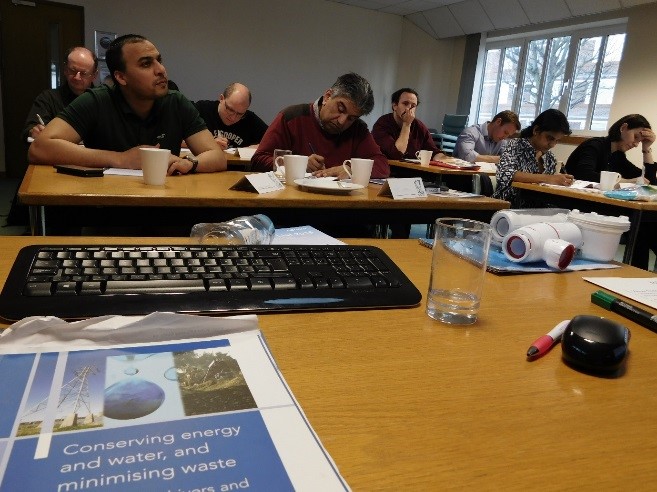
Water efficient hot and cold water system design – the problems and possible solutions
Posted on: March 2019John Griggs
Water efficient hot and cold water system design – the problems and possible solutions
| About the author: John Griggs is a water and wastewater consultant with Water and More, who has researched water efficiency, water supply and drainage issues. The results of his work have been used in UK Building Regulations, British and European Standards and various BRE Good Building Guides. He is a Fellow of the Chartered Institute of plumbing and heating engineering, as well as a honorary Fellow of CIBSE's Society of Public Health Engineers and he frequently lectures on sanitation and water efficiency at CIBSE training events. He is a founder member of SWIG (Sustainable water industry group) and has recently been working for the Gates Foundation on non-sewered sanitation. He is currently co-writing a book on modern drainage design with Kemi Adeyeye. |
 |
|
This situation is epitomised in the area of water efficient design where out of date Regulations, design assumptions and practices result in oversized, inefficient wasteful water systems that can also be health risks. Something has to change, but the plumbing industry and many architects are highly resistant to change. ‘If it worked in the past then it should work today’, is a maxim that is often used by people who want to preserve their way of doing things and pass it on to future generations. But, things do and have changed.
Over my lifetime I have seen kitchens evolve from a humble small room with a sink and a cooker to palatial domains with sinks and various, often concealed, high-tech devices such as washing machines, dishwashers, drinking water coolers, boiling water dispensers, coffee machines and internet connections! Yet, people still use Loading Units for water system design that are based upon 1950’s washing machines. In the bathroom we still have a bath, WC and a basin (please do NOT call it a sink!), but in many homes the bath may have been replaced by a shower and in most new homes there will be the number of bathrooms to match the number of bedrooms. Having more appliances does not mean that you need more water as you can only have one bath at a time. OK, in a family situation you might get a couple of people taking showers or baths at the same time, but in general the likelihood of simultaneous use of appliances is low; unless we talk of a high number as might occur in a hotel or a similar large building or development.
The current LUNA (Loading Units Normalisation Assessment) project, being led by CIBSE and CIPHE, aims to produce a new sizing methodology for water supply systems. This should result in some initial design recommendations in a year or so, but so far has compared the existing design codes and Standards to some initial real-life data. The results which you can download from www.cibse.org show that, in general, all existing design methods oversize pipework by factors ranging from 2 to about 10. The result is: overheating of buildings- due to standing losses, reduced turn-over of water within the pipework – leading to stagnation issues, waste of space and resources - due to oversized storage vessels and pipework, and prolonged waiting times for water of the desired temperature. However, the fear of underproviding water is a major concern as the responsibility – and liability- for not delivering the required flowrates to all appliances is regularly passed down the construction line to the designer or installer.
To change the situation, contracts need to be revised. They should not simply specify the current or even worse, the previous available Standard for design. Often within a Standard there are a number of options for design methods and simply specifying a Standard does not clearly identify what process or option is required. It would be far better if specifiers clearly described the desired performance required of the system. For example, ‘water delivery at basin taps to provide water of a suitable temperature for hand washing, within 5 seconds at 50% flow’. This would give the designer the options of using a circulation system, a point-of use water heater, an atomised cold water supply or another method to produce the desired outcome. Simply using the HSE recommendation of hot or cold water after running the tap for a number of minutes, is of no use to in most applications today. The HSE guidance states ‘hot water at each outlet to reach 50oC, within one minute of turning on the tap ’[HSG274 Part 2 clause 2.37] Although in the past there was not the technology to achieve much better than cold water after 2 minutes, today there is. Also, we should not be limited to ‘delivering cold water at a temperature that is as close to the incoming water temperature within two minutes of running’ [HSE guidance from HSG274 Part 2 clause 2.36]. We can now reduce cold water to specific temperatures, using heat pumps and other techniques , so the specification should be to provide cold water below, say, 15°C at all points of discharge. This would stop designers running cold water pipes near hot water or heating pipes for considerable distances and force installers to fit effective insulation to all pipes to reduce losses and gains from the surroundings.

If you can help provide water use data that could be beneficial in improving the design process of water systems, please contact the LUNA researcher Achala, by emailing her at AWickramasinghe@cibse.org
If you have any comments on this item, as a whole, please contact John at Water&More Ltd via jpjn99@gmail.com



